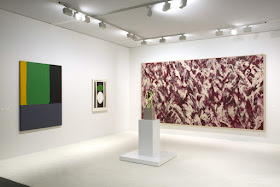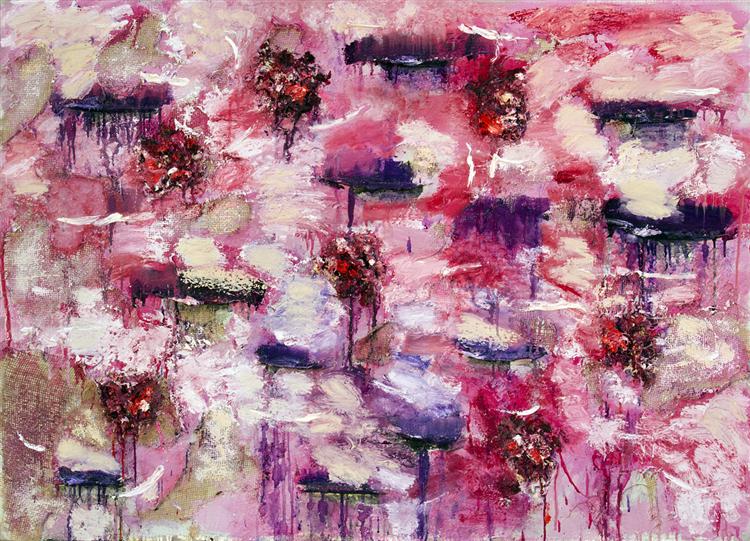 |
| Lee Krasner, Autumnal Red, 1980, oil and collage on canvas, 56' x 73" |
Lee Krasner has always been a big question mark. For most of her life, unfairly or not, she languished in the shade of her famous husband, Jackson Pollock. Is she a hell of a painter in her own right, and his equal? Is she the beneficiary of his success or cursed by it? We will never know the answers to most of the questions surrounding this quietly central figure in the history of America's most original, powerful, and influential art movement.
 |
Untitled, 1965 gouache on paper 25 x 38 inches, signed and dated |
For example, was it instead Pollock who was the beneficiary of Krasner's vision and art smarts and inspirations and aspirations and genius? A lot of smart people seem to think so. The timeline suggests that she was at the very least a catalyst and guide and counsel at a critical moment in his history. Just how impossible was the glass ceiling for any woman painter like Lee Krasner? Will she be forever the B to his A? A foot note in his glorious history. Can she ever be set free? A lot of people have tried. Can future generations of artists and art historians and art lovers see that playing field level? One would hope so.
 |
| Pollock and Krasner in the studio, 1949 |
Six months after her death at the age of 75, in 1984, the Museum of Modern Art in New York gave her a retrospective. These are the things every wishful young would-be artist is warned about.
 |
| Lee Krasner, Celebration, 1960, Cleveland Museum of Art |
But then again fame and success and recognition are not why artists are born. She must have known that. But still, when everyone is fawning over your partner, the person you painted along side, struggled along side, suffered along side, celebrated along side, and carried half the time, it has to be a bitter pill.
 |
| Lee Krasner, Robert Miller installation view, 2016 |
I once stood and chatted with the artist Pat Passloff, not that she was ever the kind of person that chatted, while people literally lined up to trip all over her more celebrated painter husband, Milton Resnick, and the hurt and yearning and pain and rage was palpable as she looked on. It would have taken a team of miners to have plumbed the depths of those emotions and have lived to tell about it.
 |
| Night Creatures, 1965, acrylic on paper, 30 x 42" |
That Pollock died young at 44 in 1956 must have made things a little different. Perhaps there was some measure of consolation that she would not just stand him, stand for him, but stand in for him and become synonymous with him. Pollock-Krasner. Still, people think and talk and write about him all the time without mentioning her, and that just doesn't happen the other way around.
 |
| Lee Krasner |
So no, we will never know the answer to all of these questions. I can't even say if she was a hell of a painter. But...all of that aside, she sure made some damn good paintings! Some damn good paintings in her own right. Some damn good paintings that don't just stand up, and hold up, along side her husband, Pollock, her teacher, Hans Hoffman, her peers, and in the history books, but stand up and hold up in and of themselves, as powerful examples of what makes life beautiful and special and meaningful and worth living, and locates a place in time that she helped define, for posterity. I'm sorry, but you can't do better than that. You really can't ask for more than that.
 |
| Lee Krasner Another Storm, 1963 signed and dated bottom right oil on canvas 94 x 176 1/4 inches |
Lee Krasner's 1963 painting "Another Storm" could stand alongside the Winged Victory of Samothrace in the Louvre. Alongside the Mona Lisa in the Louvre. Picasso's Guernica. Rothko in the Tate. Turner in the Tate. Happily. Monet's Waterlilies. Alongside Jackson Pollock anywhere. Hans Hoffman anywhere. Lee Krasner's Another Storm is an inspiration. Lee Krasner's Another Storm is a knockout. Lee Krasner's Another Storm is a vision of hope for generations to come.
 |
| Detail, Another Storm |
Lee Krasner's Another Storm is not influenced, or in anyone's shadow, but a powerful, original masterpiece, an epic painting filled with what would seem to be several lifetimes of wisdom and experience. True to its name, it thrashes about with all of the scope of Shakespeare at his grandest, of Mozart or Beethoven at their grandest, of nature at its grandest, of life as we have come to know it as a sweeping, at once glorious and awesome and terrifying and joyful and heartbreaking and ugly and beautiful and chaotic and harmonious spectacle impossible to put into words but left to artists to try to capture, to give us some idea, to remind us and share with us. Lee Krasner's Another Storm is nothing short of a revelation.
 |
| Another Storm, Robert Miller Gallery installation, 2016 |
Addison Parks
Artdeal Magazine
Spring Hill, November 2016
 |
| Another Storm, Paul Kasmin booth at Art Basel in Miami Beach, 2016 * |
 |
| Lee Krasner after Pollock |


































